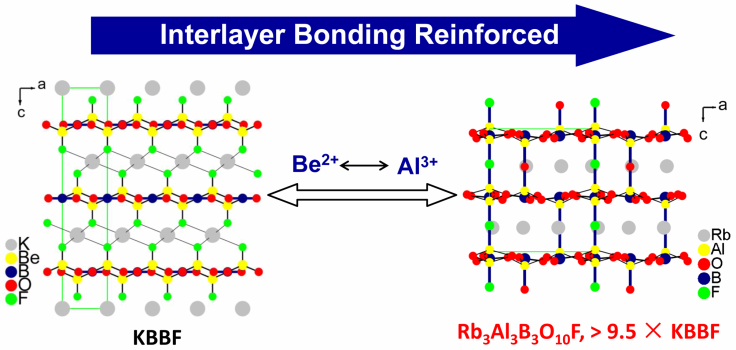Deep-ultraviolet (DUV, wavelength below 200 nm) coherent light plays an important role in semiconductor photolithography, laser micromachining, modern scientific instruments, and so forth. KBe2BO3F2 (KBBF) is the benchmark DUV NLO material, but it contains highly toxic beryllium and suffers a strong layering tendency, hindering its commercial applications. Thus, it is of great demand to develop new DUV NLO materials.
A research team led by Prof. LUO Junhua from Fujian Institute of Research on the Structure of Matter, Chinese Academy of Sciences, obtained a new beryllium-free DUV NLO material, Rb3Al3B3O10F (RABF), by the substitution of Be for Al according to the diagonal relationships of the periodic table of elements. RABF preserves the structural merits of KBBF; that is, in its structure the [Al3(BO3)OF]∞ single layer keeps the favorable arrangement of the NLO-active [BO3]3- groups in the KBBF structure.
As a result, RABF is transparent down to the DUV spectral region; its powder SHG response (1.2 × KDP) is comparable to that of KBBF, and it is phase-matching. Furthermore, the [Al3(BO3)OF]∞ single laryes are tightly bridged via Al-F and Al-O bonds, which provide a very strong interlayer bonding of about one order larger than that of KBBF, i.e., > 9.5 × KBBF. Preliminary experiments found no layering growth tendency for RABF crystal.
Moreover, co-authors Prof. LIN Zheshuai et al from Technical Institute of Physics and Chemistry, Chinese Academy of Sciences, calculated the optical properties of RABF based on the first-principles theory, which give results in consistent with those of the experiments.
These findings indicate that RABF is a promising DUV NLO crystal. It is anticipated that more DUV NLO materials with good performance will be developed through the substitution of Be for Al in the beryllium borates.
The study entitled “Beryllium-Free Rb3Al3B3O10F with Reinforced Interlayer Bonding as a Deep-Ultraviolet Nonlinear Optical Crystal” has been published in J. Am. Chem. Soc..

The substitution of Be for Al led to a beryllium-free DUV NLO material, Rb3Al3B3O10F, with a reinforced interlayer bonding of 9.5 times larger than that of the benchmark KBBF (Image by Prof. LUO's group)
Contact:
Prof. LUO Junhua
Fujian Institute of Research on the Structure of Matter
Chinese Academy of Sciences
Fuzhou, Fujian 350002, P. R. China
E-mail: jhluo@fjirsm.ac.cn